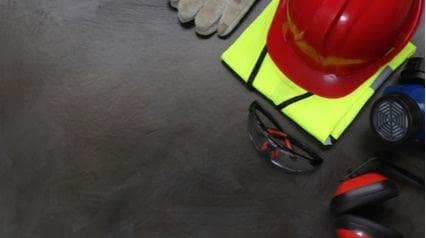What is PPE?
PPE stands for Personal Protective Equipment and refers to the clothing, equipment, and accessories used to protect against a variety of hazards. Working in a hazardous environment can be very dangerous, which is why employees need to wear PPE. This type of gear is designed to protect a person from potential workplace hazards.
These includes:
- Head protection: Hard Hats, Helmets
- Eye protection: Safety Goggles
- Ear protection: Earmuffs, earplugs
- Face protection: Face Shields
- Hand protection: Different types of gloves
- Foot protection: Steel boots
- Body protection: Vest, Jackets
What is OSHA Standard for PPE Use?
Let’s first define OSHA, It stands for Occupational Safety and Health Administration. OSHA has a regulation that requires employers to provide Personal Protective Equipment (PPE) to employees who are exposed to hazards
The OSHA has a standard for the use of PPE which is found in the general industry standard for personal protective equipment Occupational Safety and Health Administration (OSHA) regulation 29 CFR 1910.132.
According to OSHA, “Employers must provide PPE whenever employees are exposed to hazards that necessitate its use. The type and amount of PPE required will depend on the specific hazard.”
PPE Requirements
What are the requirements for PPEs? All PPEs must meet some of these minimum requirements when used to effectively protect from workplace hazards:
1. Have a safe design
The protective equipment or gear must have no protruding parts that could snag, puncture, or abrade the skin. It must fit well so that it does not move around or fall off.
2. Be of appropriate size
PPE must be of the correct size for the person who will be wearing it. It must comfortable to use and fit snugly to avoid interfering with the movements of the wearer.
3. Use safe materials
The materials used in PPE must be tested and found to be safe for use by humans. They must also be able durable enough to withstand the wear and tear of repeated use.
4. Be easy to clean
PPE must be easy to clean and disinfected so that it can be kept free and safe from contaminants and biological hazards that could cause infection.
5. Must be marked distinctively
PPE must be distinctly marked with the manufacturer’s name, trademark, or other symbol indicating the identity of the manufacturer.
What are the 4 levels of PPE?
The PPE is used as a hazard control measure. It is divided into four categories or levels. These are:
LEVEL A
These are PPEs that offer the highest level of protection from airborne diseases or skin infections and include items such as:
- Full face-piece self-contained breathing apparatus (SCBA)
- Chemical-resistant gloves and boots
- Disposable boots and gloves
- Vapor-protective suit
When selecting level A PPE, it is important to consider the severity of the hazard and how much exposure the user will be subjected to. For example, a full-body suit would be required if there was a risk of chemical exposure or a high-risk infection.
LEVEL B
Protection at level B is necessary during times when the highest level of respiratory protection is required. However, a lesser level of skin protection is necessary. These include items such as:
- Full face-piece self-contained breathing apparatus (SCBA)
- Bodysuits
- Faceshields
- Gloves
- Hooded chemical-resistant clothing
- Chemical-resistant boots
For example, an abandoned outdoor hazardous waste sites have vapor or gas levels that have not reached concentrations high enough to warrant level A protection.
LEVEL C
Level C PPE is used when there is concentration and type of airborne substances is present or there is a need to use air purifying respirators in the area. Level C includes:
- Chemical-resistant gloves
- Hard Hats
- Full-face air purifying respirator
- Boots
LEVEL D
This Level D of PPE usually used in a workplace as a uniform for daily protection or potential risk of hazardous contamination. These may include:
- Safety shoes
- Full bodysuits
- Facemask
What are the 6 Basic PPE?
There 6 basic PPEs that are usually required for employees that are exposed to hazardous environments. These includes:
- Footwear – Industrial shoes, boots, or sneakers that protect the feet from chemical spills, broken glass, and other debris
- Gloves – Chemical-resistant gloves to protect hands from harsh chemicals
- Lab coat -A lab coat protects your clothing from spills and keeps you warm in cold environments
- Eye Wear – Goggles protect your eyes from chemical splashes and other debris
- Mask – A respirator mask protects your lungs from dust and chemicals
- Earplugs or earmuff – Earplugs or earmuffs protect your ears from loud noises
Train Employees on Proper Safety Practices
Creating a strong safety culture is more than just establishing a clear set of work instructions and using the right PPE. It’s about making sure that your workforce understands those guidelines so they can get the job done right without putting themselves or their colleagues at risk. The best way to enforce this and ensure safety in the workplace is by using SafetyCulture (formerly iAuditor)’s, Training. SafetyCulture is a mobile-ready safety software that also comes with training modules to help improve safety in the workplace.
There are many uses for PPE, such as construction, manufacturing, medicine, and more. A good and effective training on proper PPE use can help communicate to your workers the importance of following their work instructions. It can take them through the step-by-step process of how to carry out their tasks safely and effectively, bringing everyone on the same page when it comes to workplace safety.
The good news is, training doesn’t have to be a big investment of time or money anymore. Convert your work instructions, user guides, and technical standards into interactive, bite-sized training that your team can easily complete in minutes – not days or weeks.



